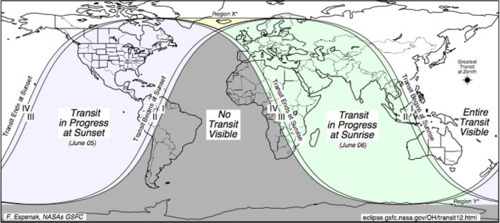The transit of Venus is conceptually like a solar eclipse, in which the moon passes between Earth and the sun. Due to the moon's proximity to us, it blocks all or most of the sun when they cross paths, but Venus is much further away, so the amount of the sun it will block is much smaller. The only way to see it properly is with a telescope or camera with a solar filter (do not look at the sun without one of these filters or eclipse glasses to protect your eyes).
If you have the right solar filter and telescope or zoom lens, you can observe the transit yourself. In North America, it will be visible in the afternoon and evening, until sunset. The transit will not be visible to everyone: in most of South America, Western Africa, Spain, and Portugal it will occur in the middle of the night.
 |
| Photo credit: NASA http://venustransit.nasa.gov/2012/transit/viewing_locations.php |
If you don't have the proper equipment, or if you fall into the zone where the transit will not be visible, NASA will have a live feed of the sun on their website at their astronomy photo of the day site: http://apod.nasa.gov/apod/astropix.html. You can also see the transit at http://venustransit.gsfc.nasa.gov/data/. The event begins at 3:09PM Pacific Time and will last a little over six and a half hours.
No comments:
Post a Comment